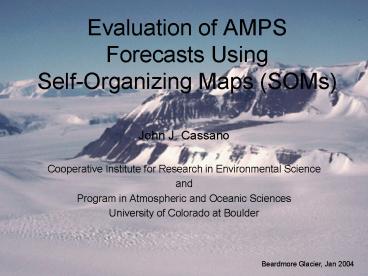Evaluation of AMPS Forecasts Using SelfOrganizing Maps SOMs - PowerPoint PPT Presentation
1 / 15
Title:
Evaluation of AMPS Forecasts Using SelfOrganizing Maps SOMs
Description:
For these time periods determine which nodes the model predictions map to ... Compare model predictions to in-situ atmospheric measurements ... – PowerPoint PPT presentation
Number of Views:68
Avg rating:3.0/5.0
Title: Evaluation of AMPS Forecasts Using SelfOrganizing Maps SOMs
1
Evaluation of AMPSForecasts UsingSelf-Organizing
Maps (SOMs)
- John J. Cassano
- Cooperative Institute for Research in
Environmental Science - and
- Program in Atmospheric and Oceanic Sciences
- University of Colorado at Boulder
Beardmore Glacier, Jan 2004
2
Outline
- What are SOMs?
- Application of SOMs for model evaluation studies
- Application of SOM Analysis to AMPS data
- Conclusions / Future Work
3
What are SOMs?
- SOM - Self-Organizing Map
- SOM technique uses an unsupervised learning
algorithm (neural net) - Clusters data into a user selected number of
nodes - SOM algorithm attempts to find nodes that are
representative of the data in the training set - More nodes in areas of observation space with
many data points - Fewer nodes in areas of observation space with
few data points - SOMs are in use across a wide range of
disciplines
4
Application of SOMsfor Model Evaluation Studies
- Synoptic pattern classification
- Frequency of occurrence of synoptic patterns
- Determine model errors for different synoptic
patterns
5
Application of SOM Analysis to AMPS Data
- Train SOM with AMPS SLP data
- Result is a synoptic pattern classification
- Evaluate frequency of occurrence of synoptic
patterns predicted by AMPS as a function of
forecast duration - Map 0h, 24h, and 48h forecasts to SOM
- Mis-mapping of AMPS forecasts
- Model validation statistics for specific synoptic
patterns (ongoing work) - Calculate model error statistics at points of
interest (Willie Field) for different synoptic
patterns - Are certain synoptic patterns prone to bias (e.g.
error in predicted wind speed or direction)?
6
AMPS Data for SOM Analysis
- SLP over Ross Sea sector of AMPS 30 km model
domain - Summer only (NDJ)
- 00Z AMPS simulations from Jan 2001 through Feb
2003 - 186 model simulations
- Evaluate 0, 24, and 48 h AMPS forecasts
7
AMPS SOM Analysis Domain
8
Synoptic Pattern Classification
9
Frequency of Occurrence
10
Misprediction of Synoptic Patterns
- Consider all of the time periods for which the
model analyses map to a particular node - For these time periods determine which nodes the
model predictions map to - From this analysis we can determine biases in the
model predictions of specific synoptic patterns
relative to the model analyses - Percent of cases that map to the correct node
- Mis-mapping of model predictions between nodes
11
AMPS 24h Forecasts
12
AMPS 48h Forecasts
13
Model Errors for Synoptic Patterns
- Compare model predictions to in-situ atmospheric
measurements - Calculate model validation statistics for all
time periods that map to each node - Look for model errors that vary from node to node
- This is ongoing work using AMPS data
- This technique has been applied to ARCMIP data
14
An ARCMIP exampleSHEBA Surface Pressure (DJF)
15
Conclusions / Future Work
- The use of SOMs provides an alternate method of
evaluating model performance - Identify synoptic patterns which are over or
underpredicted - Determine model tendency for mis-prediction of
certain synoptic types - Provide information on model errors related to
specific synoptic patterns - Complete SOM analysis for entire AMPS archive
(Jan 2001 - present) - Calculate model biases as a function of forecast
time and synoptic patterns































